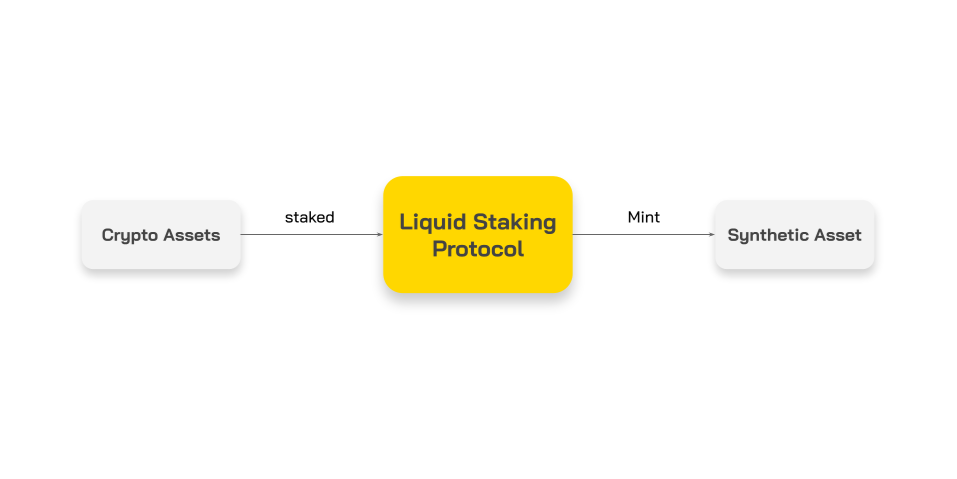What is Liquid Staking? Will Liquid Staking become a new trend?
What is Liquid Staking? Is this a new trend in the future? What are the key points to finding an excellent Liquid Staking project?
Liquid Staking is a keyword that has been mentioned since the summer of 2020, and recently we have started to see a few projects in this sector rise. In this article, let's learn what Liquid Staking is with FoxCryptoNews? Is this a sustainable sector and can develop in the future?
What is Liquid Staking?
Liquid Staking is used to describe protocols that allow the creation of synthetic assets in the form of fungible tokens of assets staked in a decentralized network.
Thereby, the Liquid Staking Protocol allows staking assets to be bought & sold, liquid on other markets, and can use synthetic assets as collateral in applications Decentralized Finance (DeFi).

For example, Acala’s “Staking Liquidity” feature allows users to Staking KSM and receive LKSM in return.
In addition to receiving staking rewards from staked KSM, users can also use LKSM in other protocols on Acala to mint kUSD, or participate in liquidity & Liquidity farming.
Why does Liquid staking have a chance to thrive in the future?
Proof of Stake (PoS) has now become a popular standard for securing decentralized networks, PoS has many advantages over PoW - Proof of Work, including faster block generation time, operating costs lower, higher throughput and lower ecological impact,...
FoxCryptoNews has an article explaining why Proof of Stake is more secure and widely used than Proof of Work, you can refer to it for better understanding!
Watch now: 3 reasons why Proof of Stake is more secure than Proof of Work
Therefore, the majority of new blockchains opt for PoS, or PoS customizations, to secure the network. For those of you who don't know, the world's second largest decentralized network, Ethereum, is also in the process of gradually moving from PoW to PoS and becoming Ethereum 2.0.
In PoS networks and most PoS customizations, native tokens are used as collateral to identify participants (“validators”) in the consensus process (“staking”).
To ensure that the Validators do not cheat in transaction confirmation & validation, PoS protocols will lock the number of native tokens staking, and may confiscate or burn the tokens that the validator has staked in case of detecting behavior. cheat.
Liquid Staking allows Validators or Delegators to use capital more efficiently. When users deposit native assets into staking protocols, users can participate in the security of the network and receive block rewards.
In addition, users receive back synthetic assets in the form of fungible tokens representing staked tokens, which users can use to use in supported protocols to earn additional profits.
For example: Deposit ETH to Lido to receive stETH and block reward. Then, use liquidity-providing stETH in Curve or Saddle for an additional Liquidity Mining bonus.
Summary:
- When there is no Liquid Staking Protocol, users can choose: staking in the protocol to participate in network security and receive block rewards, or join DeFi to make a profit ⇒ choose 1 of 2.
- With Liquid Staking Protocol, users can do 2 ⇒ 2 in 1.
Outstanding Liquid Staking Protocol projects
Currently, Liquid staking has grown in several prominent ecosystems, notably Ethereum, Polkadot & Kusama.
Ethereum
Ethereum is the cradle of DeFi and is currently also one of the fastest growing DeFi places. This causes large amounts of ETH to be locked up in DeFi Protocols.
Liquid Staking Protocol helps to unlock a large amount of liquidity locked in DeFi & Staking protocols in PoS ETH 2.0, making capital flow more efficient.
Lido is considered to be the most powerful Liquid Staking Protocol on Ethereum, the project tends to expand horizontally when supporting the Terra system and soon Solana.

Kusama & Polkadot
Kusama & Polkadot's Tokenomic makes projects need a lot of KSM & DOT to auction parachain slots, making Liquid Staking the perfect solution for this ecosystem.
Due to technical limitations from the Kusama & Polkadot platform, the above projects cannot currently launch the mainnet on the Kusama & Polkadot relay-chain. But in the next 6 - 12 months, the picture of Liquid Staking on this ecosystem is likely to grow much stronger than it is now. Some outstanding projects can be mentioned such as: Karura & Acala, Bifrost, Stafi, ...
Learn more: What do you know about Polkadot and Kusama?
How Liquid Staking brings sustainable benefits to stakeholders
The business model in Crypto is not much different when compared to traditional finance, it is a framework that briefly, intuitively and systematically describes how to bring long-term value to a project, user use and capture value through sound monetization strategies.

As for Liquid Staking Protocol, I realize that this project team is providing a network product that benefits many parties, including:
- User: The most intuitive, helping users to earn more profit from both sources: block reward + incentive from DeFi Protocol ⇒ Increase capital efficiency.
- Network: When many users staking tokens into the Liquid Staking Protocol, it means joining the common network, indirectly increasing network security and making the network more decentralized.
- Other DeFi protocol: Users using synth tokens from Liquid Staking Protocol increase TVL & Volume for those projects.
⇒ In general, as the use of users increases, the benefits to stakeholders also increase. This is the positive network effect.
Currently, the only application used for this project team is Governance - participating in ecosystem governance of the Liquid Staking project. But there are 2 other applications that are much more remarkable that it is likely that projects of this group will apply to the mainnet in the future:
- Shared protocol fees.
- Governance - Participate in ecosystem governance of the Liquid Staking project and related L1s.

Share Protocol Fee
Most Liquid Staking projects calculate the protocol fee by charging a part of the fee on the profit earned by users, in my opinion this is a reasonable way of charging, based on the principle of mutual benefit.
The project may share all or part of the protocol fee to token holders or stakers by some means.
Example: User Staking 1,000 ETH into Lido with APR of 4.4%. After one year, that person withdraws capital from Lido, they will receive their capital back plus profit from the block reward, equivalent to:
1,000 + 1,000*4.4%*90% = 1039.6 ETH
On the Lido side, the project receives a protocol fee in return:
1,000*4.4%*10% = 4.4 ETH

In fact, Lido's Liquid Staking product is launching on two L1s, Ethereum and Terra, do a quick calculation with the above data (assuming TVL & APR do not change), then the Protocol fee that Lido earns every year around $25M.
4,085,572,316*0.44% + 1,994,361,835*0.34% = $24,757,348.4294
Governance
Basically, by holding a certain amount of staking tokens in the networks, the Liquid Staking Protocols have the right to participate in the governance of that L1 project.
Assuming the Liquid Staking Protocols give this authority to LDO holders, I think this is an outstanding use case of the project team. Then, holding the native token of Liquid Staking Protocol is equivalent to being able to participate in the governance of related ecosystems.
The Future of Liquid Staking
In my personal opinion, I think Liquid Staking will thrive in the following ecosystems:
Kusama / Polkadot
Parachain Slot Auction will cause a very large amount of KSM & DOT to be locked and do nothing, Liquid staking is a very suitable product for the Kusama / Polkadot ecosystem as it releases a large amount of assets to the secondary market.
The L1s have DeFi in full swing
Some L1s have active DeFi projects such as Ethereum, Terra, Solana.
In theory, all blockchain PoS is a potential market for Liquid Staking to grow, but if the DeFi ecosystem of those blockchains themselves does not develop, how can the issued Synthetic Assets be used?
So, in fact, only blockchains with a thriving DeFi ecosystem can the Liquid Ztaking team develop sustainably, based on foundational DeFi pieces such as AMM, lending, etc.
Investment opportunity with Liquid Staking
In crypto, when a new trend appears, in addition to the core projects with long-term development orientation in the same sector, there will also be new projects springing up to follow, making short-term. So how to identify potential projects that can bring high ROI in the project team working on Liquid Staking? Where is the key point?
From the perspective of a Liquid Staking Protocol user, they will want to make better use of their capital to earn as much yield as possible. While the interest rate from block reward is quite low, usually below 10%, the remaining yield comes from DeFi protocols (Liquidity mining, one-side staking,...).
So, as a synth asset released by a Liquid Staking Protocol is adopted by more and more DeFi protocols, the more options and tactics available to the combined users.
So, in my personal opinion, the adoption & adoption of synthetic assets is one of the keys to the long-term success of the projects in the Liquid Staking Protocol team.

In general, when considering investing in a project under Liquid Staking, you need to consider the following 3 factors:
- What ecosystem do you operate on? - Are DeFi ecosystems flourishing like Ethereum, Terra, Solana,...
- How project capture value for native token? - Current and future use cases, how to capture value for Native token.
- In which DeFi protocols & ecosystems are the synthetic assets issued from the project used?
Summary
Thus, FoxCryptoNews introduced you to what Liquid Staking is, whether Liquid Staking will develop in the future, and the key points to find an excellent Liquid staking project.
Disclaimer: All information in this article is for informational purposes only and should NOT be considered investment advice. Investing in cryptocurrencies involves extremely high risk and you should only invest the amount that you are willing to lose.
Oct 02, 2022

-400-400.webp)


 Future-400-400.webp)



 Movement Signals ‘Future Buy Interest’ As Bitcoin and Ethereum Supply on Exchanges Dips-400-400.webp)















